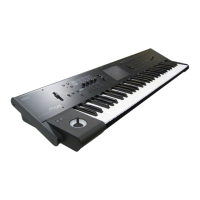PROG P2: OSC/Pitch 2–3: OSC2 Basic
25
Assigning SW1 or SW2 to Portamento On/Off
You can turn portamento on/off by using the two assignable
switches SW1 and SW2.
To do so:
1. Go to the Prog P1: Basic/Ctrls– Controllers Setup page.
2. Under Panel Switch Assign, set either SW1 or SW2 to
Porta.SW (CC#65).
Now, the selected switch will enable and disable
Portamento. It will also send the MIDI Portamento
controller, CC#65.
Even if you don’t assign SW1/2 to Portamento, you can
still use MIDI Controller #65 to turn Portamento on and
off.
2–2d: LFO1/2
LFO1 and LFO2 can both control the pitch. You can control
the strength of each LFO’s modulation in three different
ways:
• Set an initial amount of LFO modulation, using the
LFO1 Int., LFO2 Int. parameters.
•Use JS +Y Int. to adjust the amount of LFO produced by
JS+Y operations.
•Use any AMS source to scale the amount of the LFO.
The results are added together to produce the total LFO
effect.
LFO1
LFO1 Int. (LFO1 Intensity) [–12.00...+12.00]
This controls the initial effect of the LFO on the pitch, in
semitones, before any JS+Y Int. or AMS modulation.
Negative (–) settings will invert the phase of the LFO.
JS+Y Int. (LFO1 JS+Y Intensity) [–12.00...+12.00]
Specify the depth of pitch modulation produced by OSC1
LFO1 when the joystick is moved in the +Y (away) direction
(or when CC#1 is received). (Joystick control in the +Y
direction is called “JS +Y.”)
This parameter sets the maximum amount of LFO
modulation added by JS+Y, in semitones.
As this value is increased, moving the joystick in the +Y
direction will cause the OSC1 LFO1 to produce deeper pitch
modulation.
Negative (–) settings will invert the phase of the LFO. You
can also use this to reduce the initial amount of the LFO, as
set by LFO1 Int., above. For example:
1. Set LFO1 Int. to +7.00.
The LFO will now have a fairly strong effect on the pitch,
bending it by a perfect 5th.
2. Set JS+Y Int. Intensity to –7.00.
Now, if you move the joystick up, the effect of the LFO will
fade away. When the joystick is all the way at the top of its
range, the LFO will be completely cancelled out.
AMS (LFO1) [List of AMS Sources]
This selects any AMS modulation source to scale the amount
of the LFO applied to pitch.
For a list of AMS sources, please see “AMS (Alternate
Modulation Source) List” on page 374.
Intensity [–12.00...+12.00]
This controls the depth and direction of the AMS (LFO1)
modulation for pitch.
With a setting of 0, modulation will not be applied. With a
setting of 12.00, the OSC1 LFO1 will apply a maximum of
+/–1 octave of pitch modulation.
For example if AMS (LFO1) is set to JS+Y: CC#01 and you
move the joystick in the +Y direction, pitch modulation from
OSC1 LFO1 will be applied in positive phase if this is a
positive (+) value, or applied in negative phase if this is a
negative
(–) value.
LFO1 Int., JS+Y Int., and AMS (LFO1) settings are summed
to determine the depth and direction of pitch modulation
produced by OSC1 LFO1.
LFO2:
The parameters for LFO2 are identical to those for LFO1. For
more information, please see the descriptions under LFO1,
above.
▼2–2: Menu Command
• 0: Write Program ☞p.73
• 1: Exclusive Solo ☞p.73
• 2: Copy Oscillator ☞p.74
• 3: Swap Oscillator ☞p.74
For more information, please see “Program: Menu
Command” on page 73.
2–3: OSC2 Basic
This page controls the basic settings for Oscillator 2. It is
available only when the Oscillator Mode is set to Double; if
not, the page will be grayed out.
The parameters are identical to those for Oscillator 1, as
described under “2–1: OSC1 Basic,” on page 21.
2–4: OSC2 Pitch
This page controls the pitch settings for Oscillator 2. It is
available only when the Oscillator Mode is set to Double; if
not, the page will be grayed out.
The parameters are identical to those for Oscillator 1, as
described under “2–2: OSC1 Pitch,” on page 23.

